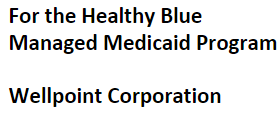
 | Clinical UM Guideline |
| Subject: Ambulatory or Outpatient Surgery Center Procedures | |
| Guideline #: CG-SURG-10 | Publish Date: 01/30/2025 |
| Status: Reviewed | Last Review Date: 11/14/2024 |
| Description |
This document addresses procedures performed in the ambulatory or outpatient surgery centers.
Ambulatory surgery refers to surgical or invasive procedures performed by qualified providers in ambulatory or dedicated surgical suites with pre-procedural and immediate post-procedural care on the same day or observation admissions without hospitalization (Patient Selection Criteria for Ambulatory [Same Day] Surgery VHA Handbook).
Note: Please see the following related documents for additional information:
| Clinical Indications |
Note: The medical necessity of the procedure may be separately reviewed against the appropriate criteria.
Medically Necessary:
The use of an outpatient or ambulatory surgery center (ASC) facility, rather than an office-based setting, is considered medically necessary when any of the following criteria are met:
Not Medically Necessary:
All other uses of outpatient or ASC facility, rather than an office-based setting, are considered not medically necessary.
| Coding |
Coding edits for medical necessity review are not implemented for this guideline. Where a more specific policy or guideline exists, that document will take precedence and may include specific coding edits and/or instructions. Inclusion or exclusion of a procedure, diagnosis or device code(s) does not constitute or imply member coverage or provider reimbursement policy. Please refer to the member's contract benefits in effect at the time of service to determine coverage or non-coverage of these services as it applies to an individual member.
| Discussion/General Information |
While hospitals continue to provide essential services for serious illness, much health care takes place in the ambulatory setting. More than half of all surgery in the United States is performed on an ambulatory basis (Patient Selection Criteria for Ambulatory [Same Day] Surgery VHA Handbook). Ambulatory (or outpatient) surgery provides an efficient and flexible means to provide many surgical or invasive procedures without requiring an inpatient hospital admission. With advances in healthcare delivery and the advent of new technologies, the list of such services continues to expand. While it is important to emphasize that both the complexity of the procedure and the individual’s clinical conditions may compromise the safety of an office-based procedure, we provide the following examples of procedures which would generally not warrant use of an ambulatory or outpatient surgery center:
| References |
Government Agency, Medical Society, and Other Authoritative Publications:
| Index |
Ambulatory or Outpatient Surgery Center Procedures
Ambulatory Surgery Center Procedures
Outpatient Surgery Center Procedures
| History |
| Status | Date | Action |
| Reviewed | 11/14/2024 | Medical Policy & Technology Assessment Committee (MPTAC) review. Revised Discussion/General Information and References sections. |
| Reviewed | 11/09/2023 | MPTAC review. Updated Description, Discussion/General Information and References sections. |
| Reviewed | 11/10/222 | MPTAC review. Updated References section. |
| Reviewed | 11/11/2021 | MPTAC review. Updated References section. |
| Revised | 11/05/2020 | MPTAC review. Minor typographical revisions made in Clinical Indications section. Updated References section. |
| Reviewed | 11/07/2019 | MPTAC review. Updated References section. |
| Reviewed | 01/24/2019 | MPTAC review. Updated Description/Scope, and References sections. |
| Revised | 01/25/2018 | MPTAC review. Revised bullet B2 in the medically necessary criteria; by changing ASA “class I-II” to “class III or higher”. Updated References section. |
| Reviewed | 11/02/2017 | MPTAC review. The document header wording updated from “Current Effective Date” to “Publish Date.” Updated Discussion/General Information and References sections. |
| Reviewed | 11/03/2016 | MPTAC review. Updated References section. |
| Revised | 11/05/2015 | MPTAC review. Revised medically necessary clinical indications. Added not medically necessary statement. Updated References sections. |
| Reviewed | 11/13/2014 | MPTAC review. Updated References section. |
| Reviewed | 11/14/2013 | MPTAC review. Updated References section. |
| Reviewed | 11/08/2012 | MPTAC review. Updated References section. |
| Reviewed | 11/17/2011 | MPTAC review. Updated References section. |
| Reviewed | 11/18/2010 | MPTAC review. Updated References section. |
| Reviewed | 11/19/2009 | MPTAC review. Updated References section. |
| Reviewed | 11/20/2008 | MPTAC review. Updated References section. |
| Reviewed | 11/29/2007 | MPTAC review. Updated References section. |
| Reviewed | 12/07/2006 | MPTAC review. A review of the literature from September 2005 – September 2006 did not result in a change in the clinical criteria. Revised coding language, updated References section. |
| Revised | 12/01/2005 | MPTAC review. Review based on Pre-merger Anthem and Pre-merger WellPoint Harmonization. |
| Pre-Merger Organizations | Last Review Date | Document Number | Title |
| Anthem, Inc. |
|
| None |
| WellPoint Health Networks, Inc. | 12/02/2004 | None | Ambulatory or Outpatient Surgery Center Procedures |
Federal and State law, as well as contract language including definitions and specific coverage provisions/exclusions, and Medical Policy take precedence over Clinical UM Guidelines and must be considered first in determining eligibility for coverage. The member's contract benefits in effect on the date that services are rendered must be used. Clinical UM Guidelines, which address medical efficacy, should be considered before utilizing medical opinion in adjudication. Medical technology is constantly evolving, and we reserve the right to review and update Clinical UM Guidelines periodically. Clinical UM guidelines are used when the plan performs utilization review for the subject. Due to variances in utilization patterns, each plan may choose whether or not to adopt a particular Clinical UM Guideline. To determine if review is required for this Clinical UM Guideline, please contact the customer service number on the back of the member's card.
No part of this publication may be reproduced, stored in a retrieval system or transmitted, in any form or by any means, electronic, mechanical, photocopying, or otherwise, without permission from the health plan.